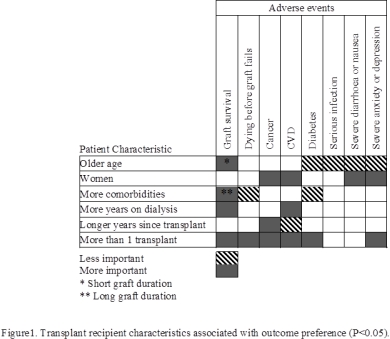Kidney Transplant Patient Preferences and Trade-Offs for Outcomes After Transplantation.
1Centre for Kidney Research, The Childrens Hospital at Westmead, Westmead, NSW, Australia
2School of Public Health, University of Sydney, Sydney, NSW, Australia
3Centre for Transplant and Renal Research, Westmead Hospital, Westmead, NSW, Australia
4Institute of Choice, University of South Australia, North Sydney, NSW, Australia.
Meeting: 2016 American Transplant Congress
Abstract number: A284
Keywords: Immunosuppression, Kidney transplantation, Outcome, Quality of life
Session Information
Session Name: Poster Session A: Poster Session III: Kidney Complications-Other
Session Type: Poster Session
Date: Saturday, June 11, 2016
Session Time: 5:30pm-7:30pm
 Presentation Time: 5:30pm-7:30pm
Presentation Time: 5:30pm-7:30pm
Location: Halls C&D
Aim: To evaluate preferences and trade-offs patients may accept to avoid adverse outcomes of long-term immunosuppression. Background: Patient preferences in clinical decisions are increasingly relevant, yet transplant patient perspectives through structured, quantified preference elicitation methods are unknown. Methods: Preferences and trade-offs between graft duration and the risk of dying, cancer, cardiovascular disease (CVD), diabetes, infection, anxiety/depression, diarrhea/nausea, and weight gain, was assessed using a best-worst scaling survey. Participants, recruited from clinics, were shown 10 scenarios with varying outcome probabilities and years of graft duration and asked to choose best, next-best, worst and next-worst outcomes. Responses were analyzed with multinominal-logit models Results: Ninety-three patients (age 18-69 years, transplant duration 0.9-31 years) completed the survey. The most important outcome was death followed by (in order), duration of graft survival, cancer, CVD, anxiety/depression, infection, diarrhea/nausea, diabetes and weight gain. A 0% risk of dying (β=1.0 95%CI:0.92,1.08) was more important than 25 years of graft survival (β=0.8 95%CI:0.64,0.78). One year graft survival (β=0.0 95%CI:-0.05,0.05) was worse than any other outcome including 100% risk of dying (β=0.19 95%CI:0.13,0.24). Preferences varied with age, gender, comorbidities, dialysis and transplant duration, and number of transplants (Fig 1). Respondents were willing to trade 2.8 (95%CI:1.8,4.1), 1.5 (95%CI:1.0,2.2), 1.1 (95%CI:0.8,1.7) and 0.7 (95%CI:0.5,1.1) years graft survival to achieve a 0% probability of cancer, dying, CVD and anxiety/depression respectively. Conclusions: Preferences and trade-offs suggest that 5 years graft survival is worse than dying and serious outcomes including cancer. Long-term clinical studies are needed to support patient preferences and shared-decisions.
CITATION INFORMATION: Howell M, Wong G, Rose J, Tong A, Craig J, Howard K. Kidney Transplant Patient Preferences and Trade-Offs for Outcomes After Transplantation. Am J Transplant. 2016;16 (suppl 3).
To cite this abstract in AMA style:
Howell M, Wong G, Rose J, Tong A, Craig J, Howard K. Kidney Transplant Patient Preferences and Trade-Offs for Outcomes After Transplantation. [abstract]. Am J Transplant. 2016; 16 (suppl 3). https://atcmeetingabstracts.com/abstract/kidney-transplant-patient-preferences-and-trade-offs-for-outcomes-after-transplantation/. Accessed December 24, 2025.« Back to 2016 American Transplant Congress
